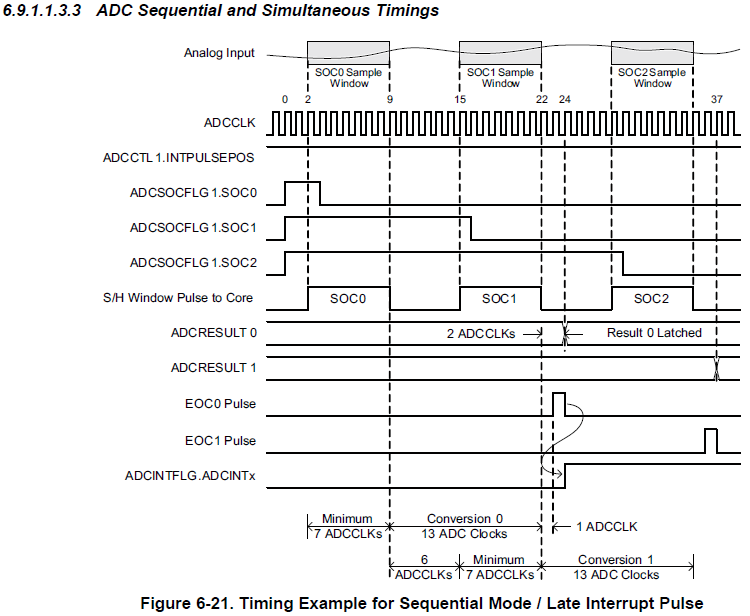Hi,
There is a lot of questions and discussions about this topic but I should admit I got lost in these topics. As a result even I tried %70 of written suggestions I could not find exact solution. Maybe I missed.
I am using Piccolo Launchpad F28027 and I want to sample analog signal at 2-3 Msps. I tried a lot of things for it but I could not exceed 750kSps at all.
ADCINT Flag controlled loop - Programming to RAM - Max sampling achieved around 750kSps
Common problem of all is that, for example when I stated PWM period to 49 (60 Mhz / 50 = 1.2 Ms should be achieved) 550-600 kSps sampling is achieved (almost half of I want).
//
// File: f2802x_examples_ccsv4/adc_soc/Example_F2802xAdcSoc.c
//
// Title: F2802x ADC Start-Of-Conversion (SOC) Example Program.
//
// Group: C2000
// Target Device: TMS320F2802x
//
//! \addtogroup example_list
//! <h1>ADC Start-Of-Conversion (SOC)</h1>
//!
//! Interrupts are enabled and the ePWM1 is setup to generate a periodic
//! ADC SOC - ADCINT1. Two channels are converted, ADCINA4 and ADCINA2.
//!
//! Watch Variables:
//!
//! - Voltage1[10] - Last 10 ADCRESULT0 values
//! - Voltage2[10] - Last 10 ADCRESULT1 values
//! - ConversionCount - Current result number 0-9
//! - LoopCount - Idle loop counter
//
// (C) Copyright 2012, Texas Instruments, Inc.
//#############################################################################
// $TI Release: f2802x Support Library v200 $
// $Release Date: Tue Jul 24 10:01:39 CDT 2012 $
//#############################################################################
#include "DSP28x_Project.h" // Device Headerfile and Examples Include File
#include "f2802x_common/include/adc.h"
#include "f2802x_common/include/clk.h"
#include "f2802x_common/include/flash.h"
#include "f2802x_common/include/gpio.h"
#include "f2802x_common/include/pie.h"
#include "f2802x_common/include/pll.h"
#include "f2802x_common/include/wdog.h"
#include "f2802x_headers/include/F2802x_CpuTimers.h"
// Prototype statements for functions found within this file.
interrupt void adc_isr(void);
void Adc_Config(void);
//#pragma CODE_SECTION(adc_isr, "ramfuncs");
// Global variables used in this example:
uint16_t AdcBuft[50];
static uint16_t *AdcBufPtr = AdcBuft;
//Sampling Rate Measurement Variables
uint32_t ctelapsed[2]={0};
long timeelapsed=0;
long adcintcount=0;
long srcorr=0;
int i=0;
ADC_Handle myAdc;
CLK_Handle myClk;
FLASH_Handle myFlash;
GPIO_Handle myGpio;
PIE_Handle myPie;
PWM_Handle myPwm;
void main(void)
{
CPU_Handle myCpu;
PLL_Handle myPll;
WDOG_Handle myWDog;
// Initialize all the handles needed for this application
myAdc = ADC_init((void *)ADC_BASE_ADDR, sizeof(ADC_Obj));
myClk = CLK_init((void *)CLK_BASE_ADDR, sizeof(CLK_Obj));
myCpu = CPU_init((void *)NULL, sizeof(CPU_Obj));
myFlash = FLASH_init((void *)FLASH_BASE_ADDR, sizeof(FLASH_Obj));
myGpio = GPIO_init((void *)GPIO_BASE_ADDR, sizeof(GPIO_Obj));
myPie = PIE_init((void *)PIE_BASE_ADDR, sizeof(PIE_Obj));
myPll = PLL_init((void *)PLL_BASE_ADDR, sizeof(PLL_Obj));
myPwm = PWM_init((void *)PWM_ePWM1_BASE_ADDR, sizeof(PWM_Obj));
myWDog = WDOG_init((void *)WDOG_BASE_ADDR, sizeof(WDOG_Obj));
InitCpuTimers();
// Perform basic system initialization
WDOG_disable(myWDog);
CLK_enableAdcClock(myClk);
CLK_enableTbClockSync(myClk);
CLK_enablePwmClock(myClk, PWM_Number_1);
(*Device_cal)();
//Select the internal oscillator 1 as the clock source
CLK_setOscSrc(myClk, CLK_OscSrc_Internal);
// Setup the PLL for x10 /2 which will yield 50Mhz = 10Mhz * 10 / 2
PLL_setup(myPll, PLL_Multiplier_12, PLL_DivideSelect_ClkIn_by_2);
// Disable the PIE and all interrupts
PIE_disable(myPie);
PIE_disableAllInts(myPie);
CPU_disableGlobalInts(myCpu);
CPU_clearIntFlags(myCpu);
// If running from flash copy RAM only functions to RAM
#ifdef _FLASH
memcpy(&RamfuncsRunStart, &RamfuncsLoadStart, (size_t)&RamfuncsLoadSize);
#endif
// Initalize GPIO
// Enable XCLOCKOUT to allow monitoring of oscillator 1
GPIO_setMode(myGpio, GPIO_Number_18, GPIO_18_Mode_XCLKOUT);
CLK_setClkOutPreScaler(myClk, CLK_ClkOutPreScaler_SysClkOut_by_1);
// Setup a debug vector table and enable the PIE
PIE_setDebugIntVectorTable(myPie);
PIE_enable(myPie);
// Register interrupt handlers in the PIE vector table
PIE_registerPieIntHandler(myPie, PIE_GroupNumber_10, PIE_SubGroupNumber_1, (intVec_t)&adc_isr);
// Initialize the ADC
ADC_enableBandGap(myAdc);
ADC_enableRefBuffers(myAdc);
ADC_powerUp(myAdc);
ADC_enable(myAdc);
ADC_setVoltRefSrc(myAdc, ADC_VoltageRefSrc_Int);
// Enable ADCINT1 in PIE
//PIE_enableAdcInt(myPie, ADC_IntNumber_1);
// Enable CPU Interrupt 1
CPU_enableInt(myCpu, CPU_IntNumber_10);
// Enable Global interrupt INTM
CPU_enableGlobalInts(myCpu);
// Enable Global realtime interrupt DBGM
CPU_enableDebugInt(myCpu);
// Configure ADC
//Note: Channel ADCINA4 will be double sampled to workaround the ADC 1st sample issue for rev0 silicon errata
ADC_setIntPulseGenMode(myAdc, ADC_IntPulseGenMode_Prior);
ADC_enableInt(myAdc, ADC_IntNumber_1);
ADC_setIntMode(myAdc, ADC_IntNumber_1, ADC_IntMode_ClearFlag);
ADC_setIntSrc(myAdc, ADC_IntNumber_1, ADC_IntSrc_EOC1);
ADC_setSocChanNumber (myAdc, ADC_SocNumber_0, ADC_SocChanNumber_A4);
ADC_setSocChanNumber (myAdc, ADC_SocNumber_1, ADC_SocChanNumber_A4);
ADC_setSocTrigSrc(myAdc, ADC_SocNumber_1, ADC_SocTrigSrc_EPWM1_ADCSOCA);
ADC_setSocSampleWindow(myAdc, ADC_SocNumber_0, ADC_SocSampleWindow_7_cycles);
ADC_setSocSampleWindow(myAdc, ADC_SocNumber_1, ADC_SocSampleWindow_7_cycles);
// Enable PWM clock
// Stated at begining
//CLK_enablePwmClock(myClk, PWM_Number_1);
// Setup PWM
PWM_enableSocAPulse(myPwm); // Enable SOC on A group
PWM_setSocAPulseSrc(myPwm, PWM_SocPulseSrc_CounterEqualCmpAIncr);
PWM_setSocAPeriod(myPwm, PWM_SocPeriod_FirstEvent);
//PWM_setCmpA(myPwm, 0x0080);
PWM_setClkDiv(myPwm, PWM_ClkDiv_by_1);
PWM_setCmpA(myPwm, 12); // Set compare A value
PWM_setPeriod(myPwm, 19); // Set period for ePWM1
PWM_setHighSpeedClkDiv(myPwm, PWM_HspClkDiv_by_1);
PWM_setPeriodHr(myPwm, 19);
PWM_setCmpAHr(myPwm,12);
PWM_setCounterMode(myPwm, PWM_CounterMode_Up);
// Wait for ADC interrupt
StartCpuTimer0();
ctelapsed[0]=ReadCpuTimer0Counter();
adcintcount=0;
while(1)
{
while (AdcRegs.ADCINTFLG.bit.ADCINT1 == 0);
//AdcBuft[i]=ADC_readResult(myAdc, ADC_ResultNumber_1);
*AdcBufPtr++ = AdcResult.ADCRESULT1;
if( AdcBufPtr == (AdcBuft + 50) )
{
AdcBufPtr = AdcBuft; // Rewind the pointer to beginning
}
ADC_clearIntFlag(myAdc, ADC_IntNumber_1); // Clear ADCINT1 flag reinitialize for next SOC
adcintcount++;
i++;
if(i==49){
ctelapsed[1]=ReadCpuTimer0Counter();
timeelapsed=(ctelapsed[0]-ctelapsed[1])/60000000;
srcorr=adcintcount/timeelapsed;
i=i-49;
}
}
}
interrupt void adc_isr(void)
{
/*
//discard ADCRESULT0 as part of the workaround to the 1st sample errata for rev0
Voltage1[ConversionCount] = ADC_readResult(myAdc, ADC_ResultNumber_1);
// If 10 conversions have been logged, start over
if(ConversionCount == 9)
{
ConversionCount = 0;
}
else ConversionCount++;
*AdcBufPtr++ = AdcResult.ADCRESULT1;
if(ConversionCount == 9) {
ConversionCount = 0; }
else ConversionCount++;
if( AdcBufPtr == (AdcBuft + 10) )
{
AdcBufPtr = AdcBuft; // Rewind the pointer to beginning
}
// Clear ADCINT1 flag reinitialize for next SOC
ADC_clearIntFlag(myAdc, ADC_IntNumber_1);
// Acknowledge interrupt to PIE
PIE_clearInt(myPie, PIE_GroupNumber_10);
adcintcount++;
*/
return;
}


